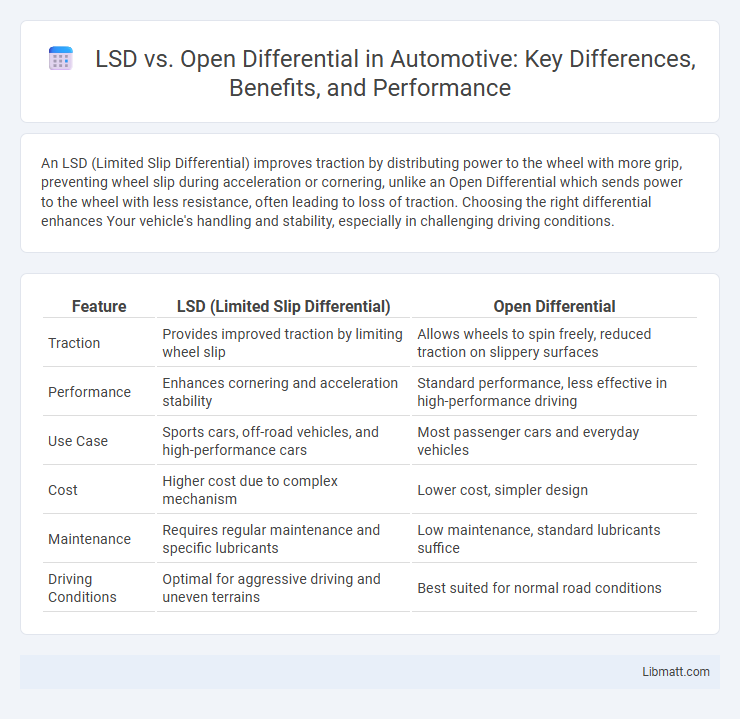An LSD (Limited Slip Differential) improves traction by distributing power to the wheel with more grip, preventing wheel slip during acceleration or cornering, unlike an Open Differential which sends power to the wheel with less resistance, often leading to loss of traction. Choosing the right differential enhances Your vehicle's handling and stability, especially in challenging driving conditions.
Table of Comparison
| Feature | LSD (Limited Slip Differential) | Open Differential |
|---|---|---|
| Traction | Provides improved traction by limiting wheel slip | Allows wheels to spin freely, reduced traction on slippery surfaces |
| Performance | Enhances cornering and acceleration stability | Standard performance, less effective in high-performance driving |
| Use Case | Sports cars, off-road vehicles, and high-performance cars | Most passenger cars and everyday vehicles |
| Cost | Higher cost due to complex mechanism | Lower cost, simpler design |
| Maintenance | Requires regular maintenance and specific lubricants | Low maintenance, standard lubricants suffice |
| Driving Conditions | Optimal for aggressive driving and uneven terrains | Best suited for normal road conditions |
Introduction: LSD vs Open Differential
Limited Slip Differentials (LSD) enhance vehicle traction by distributing torque to the wheel with the most grip, contrasting with Open Differentials that send equal torque to both wheels regardless of traction differences. LSDs improve handling and stability in performance driving and off-road conditions, reducing wheel slip during acceleration and cornering. Open Differentials offer simpler design and cost-effectiveness but can compromise control on slippery surfaces where one wheel loses traction.
How Open Differentials Work
Open differentials distribute engine torque equally to both wheels by allowing them to rotate at different speeds, especially useful during cornering. This mechanism uses a set of gears to balance rotational speed between the inner and outer wheels, preventing tire slippage. However, open differentials can lead to a loss of traction when one wheel encounters low grip, as torque is diverted away from the wheel with more traction.
How Limited Slip Differentials (LSD) Work
Limited Slip Differentials (LSD) enhance traction by distributing torque between wheels based on grip levels, unlike open differentials which split torque evenly regardless of traction. LSD uses clutch packs, gears, or viscous couplings to limit wheel slip, transferring more power to the wheel with better traction. This mechanism improves vehicle stability and cornering performance by reducing wheel spin under acceleration.
Core Differences Between LSD and Open Differential
Limited Slip Differentials (LSD) distribute torque more effectively between wheels, enhancing traction by limiting wheel spin during cornering or low-traction situations, unlike Open Differentials which allow one wheel to spin freely when traction is lost. Open Differentials prioritize smooth driving and easier turning by permitting individual wheel speeds to vary but sacrifice traction control compared to LSD systems. The core difference lies in torque distribution: LSD actively manages power between wheels, improving stability and grip, while Open Differentials offer simplicity without torque biasing.
Performance Impact: Traction and Handling
LSD (Limited Slip Differential) significantly enhances traction and handling by distributing torque more effectively between wheels, especially during cornering or on slippery surfaces, reducing wheel spin and improving vehicle stability. In contrast, an open differential allows wheels to spin independently, which can lead to reduced traction under power as torque is sent to the wheel with less grip. For your driving performance, choosing an LSD provides better control and acceleration, particularly in dynamic or challenging road conditions.
LSD vs Open Differential in Everyday Driving
LSD (Limited Slip Differential) provides improved traction compared to an Open Differential by distributing power to the wheel with more grip, enhancing stability during cornering and slippery conditions. An Open Differential sends power to the wheel with the least resistance, which can cause wheel spin and reduced control in everyday driving scenarios like rain or gravel. Your vehicle equipped with LSD will typically offer better handling and safety on varied road surfaces commonly encountered in daily driving.
LSD vs Open Differential for Motorsports
Limited Slip Differentials (LSD) provide superior traction and cornering performance compared to Open Differentials in motorsports by distributing torque to the wheel with more grip, enhancing acceleration out of turns. Open Differentials allow the wheel with less traction to spin freely, leading to reduced control and slower lap times on high-performance tracks. Professional motorsport teams favor LSDs for improved handling, stability, and power delivery under aggressive driving conditions.
Maintenance and Longevity Comparison
Limited Slip Differentials (LSD) typically require more frequent maintenance due to their complex internal clutch or gear systems, which can wear out faster under aggressive driving conditions. Open Differentials have simpler designs with fewer moving parts, resulting in longer overall durability and lower maintenance costs. Regular fluid changes and inspections extend the lifespan of both types, but LSDs generally demand more attention to maintain optimal performance.
Cost Analysis: LSD vs Open Differential
Limited Slip Differentials (LSD) typically cost between $500 and $1,500, depending on the type and vehicle compatibility, while open differentials are usually standard and add no extra cost beyond the factory price. Installation costs for LSDs can range from $200 to $600 due to the complexity, whereas open differentials require minimal maintenance and installation expenses. Your choice impacts long-term expenses, as LSDs often enhance traction and performance but may incur higher upfront and servicing fees compared to the more economical open differential.
Which Differential is Best for You?
Choosing between LSD (Limited Slip Differential) and an open differential depends on your driving needs and conditions. LSD provides better traction and handling by distributing torque to the wheel with more grip, ideal for performance or off-road driving. Your best choice hinges on whether you prioritize enhanced control in corners and slippery surfaces (LSD) or simple, cost-effective functionality for everyday driving (open differential).
LSD vs Open Differential Infographic

 libmatt.com
libmatt.com